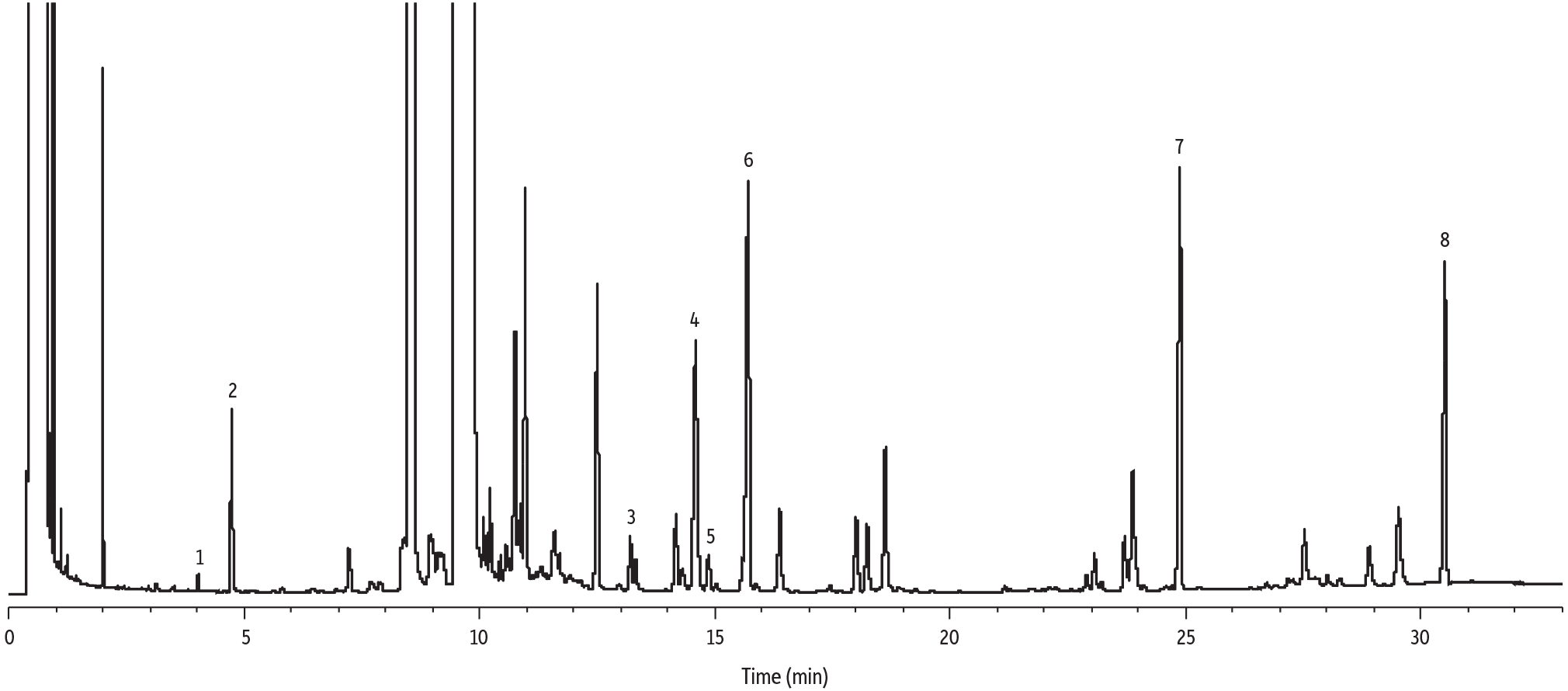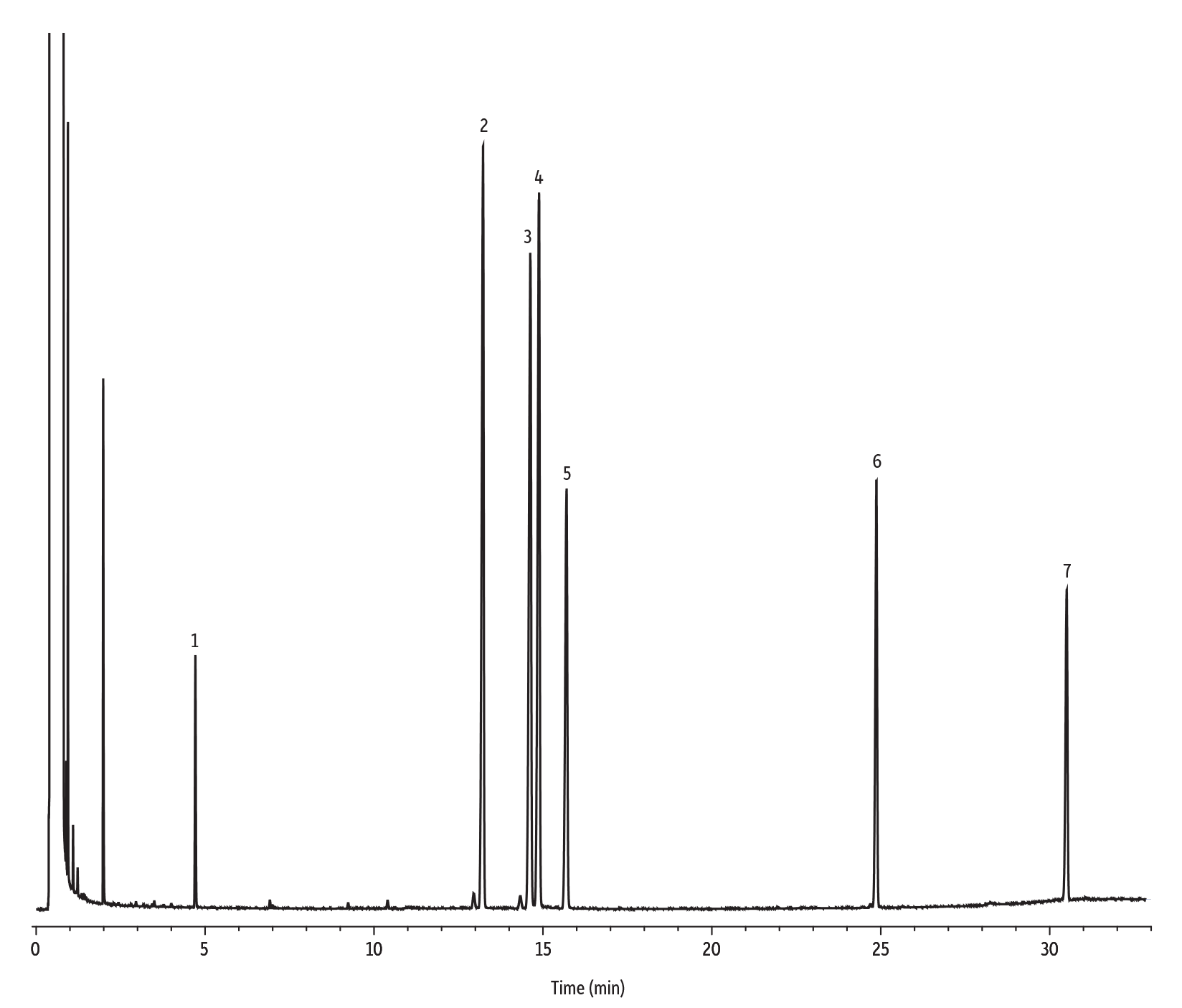Accurate Analysis of Glycerol and Glycerides in Biodiesel Oil Using EN 14105 (2011) and Robust Metal MXT Columns
- Total solution for analysis of free glycerol, mono-, di-, and triglycerides in biodiesel.
- Rugged metal MXT column ensures longevity and durability.
- Accurate determination of FAME biodiesel contaminates.
Fatty acid methyl ester (FAME) biodiesel is produced from the transesterification of triglycerides in oils and fats through a reaction that uses methanol in the presence of a catalyst (Figure 1). The main byproduct of this reaction is glycerol and, after the reaction is complete, most of the glycerol can be washed away with water. Any remaining glycerol is measured and reported as free glycerol contamination. The biodiesel reaction also has a few intermediate steps during which mono- and diglycerides are formed [1]. Mono-, di-, and unreacted triglyceride contaminants are water insoluble, which makes them more problematic to remove. The amount of residual glycerides depends on how successful the transesterification reaction was, and a poor reaction results in a fuel with insufficient stability that can significantly affect engine performance [2].
Figure 1: Step-by-step transesterification of triglycerides with the methanol to form FAME biodiesel.
The most accurate way to analyze glycerol and glycerides contamination in biodiesel is using gas chromatography (GC). European method EN 14105 (2011 version) is commonly used to determine the mass percentage of free glycerol and mono-, di-, and triglycerides in biodiesel, and it outlines the procedures for sample preparation, chromatographic analysis, and quantification [3].
GC column choice is an important consideration when analyzing glycerol and glycerides in biodiesel because eluting the high molecular weight triglycerides will challenge the thermal stability of the capillary column. Method EN 14105 recommends using a “high temperature” column, allowing either fused silica or metal capillary columns to be used. Fused silica columns, when exposed to elevated temperatures, will become brittle over time and their lifetime is generally reduced. Rugged metal MXT columns are more robust than fused silica and offer greater longevity, comparable efficiencies, and excellent inertness. In the work presented here, MXT-Biodiesel TG columns were evaluated for the analysis of glycerol and glycerides in biodiesel using EN 14105.
Definitive Chromatography Assures Accurate Results
To evaluate chromatographic performance, a B100 soy biodiesel sample was derivatized with silylation reagent (cat.# 35600) following the EN 14105 procedure. This step is important because it reduces peak tailing for polar compounds, such as monoglycerides, diglycerides, and glycerol. As shown in Figure 2, excellent peak shape and separations were obtained, which allows accurate integration and quantification. Monoglycerides can be difficult to distinguish from heavy molecular weight FAMEs due to their overlapping elution zones. Peak identification should be confirmed by derivatizing and analyzing monoglyceride standards along with internal standards following method procedures (Figure 3). Restek offers custom reference standards for this purpose, allowing labs to request specific formulations that are mixed to meet their exact needs.
Figure 2: Analysis of glycerol and glycerides in B100 soy biodiesel using EN 14105.

| Peaks | |
|---|---|
| 1. | Glycerol |
| 2. | (S)-(−)-1,2,4-Butanetriol |
| 3. | 1-Monopalmitin |
| 4. | Monoolein |
| 5. | Monostearin (l) |
| 6. | Monononadecanoin |
| 7. | 1,3-Dinonadecanoin |
| 8. | Trinonadecanoin |
| Column | MXT-Biodiesel TG with 2 m x 0.53 mm ID retention gap, 15 m, 0.32 mm ID, 0.10 µm (cat.# 70291) |
|---|---|
| Standard/Sample | Soy biodiesel B100 |
| EN 14105 standard 1 (custom) | |
| (s)-(-)-1,2,4-Butanetriol (cat.# 33032) | |
| MSTFA (N-methyl-N-trimethylsilytrifluoroacetamide) (cat.# 35600) | |
| Diluent: | Heptane |
| Injection | |
| Inj. Vol.: | 1 µL cool on-column |
| Temp. Program: | Oven track |
| Oven | |
| Oven Temp.: | 50 °C (hold 1 min) to 180 °C at 15 °C/min to 230 °C at 7 °C/min to 370 °C at 10 °C/min (hold 5 min) |
| Carrier Gas | H2, constant flow |
| Flow Rate: | 7 mL/min |
| Detector | FID @ 380 °C |
|---|---|
| Instrument | Agilent 7890A GC |
| Notes | The sample was derivatized with MSTFA according to the method EN 14105 (2011) procedure. |
Figure 3: Confirming peak identification for monoglycerides using derivatized standards is recommended to ensure they are distinguished from FAMEs that may be present in the same elution zone. (See Figure 2 for conditions.)

| Peaks | |
|---|---|
| 1. | (S)-(−)-1,2,4-Butanetriol |
| 2. | 1-Monopalmitin |
| 3. | Monoolein |
| 4. | Monostearin (l) |
| 5. | Monononadecanoin |
| 6. | 1,3-Dinonadecanoin |
| 7. | Trinonadecanoin |
Durable Metal MXT Columns Easily Meet EN 14105 Performance Requirements
For the analysis of glycerol and glycerides in biodiesel, method EN 14105 uses different quantitative approaches. According to the method, glycerol is quantified using internal standard 1,2,4-butanetriol and a calibration curve. Excellent linearity was obtained across the method-specified calibration range, indicating derivatization was complete (R2 = 1.0000).
In contrast to the calibration curve approach used for glycerol, concentrations of glycerides are determined using the response factor of the analogous internal standard for each glyceride category. Using multiple internal standards reduces mass discrimination, which can be problematic due to the wide molecular weight range of the analytes present in the sample. To test the performance of the metal MXT-Biodiesel TG column, the relative response factor (RRF) of glyceryl dinonadecanoate (Di C38) versus glyceryl trinonadecanoate (Tri C38) was evaluated following the method column performance control procedure. The RRF factor was below the method maximum RRF of 1.8. Precision among the injections was 0.7% (%RSD (n=7)) indicating good repeatability and minimal carryover of the heavy compounds.
Conclusion
As demonstrated here, MXT-Biodiesel TG columns are a good choice for the analysis of glycerol and glycerides in FAME biodiesel following the conditions outlined in EN 14105. Good chromatographic results were obtained for all analytes and the calibration data met method requirements. Because MXT- Biodiesel TG columns are made using metal capillary tubing, they are more durable at the high temperatures required for this analysis than fused silica columns and they will perform reliably over longer column lifetimes.

